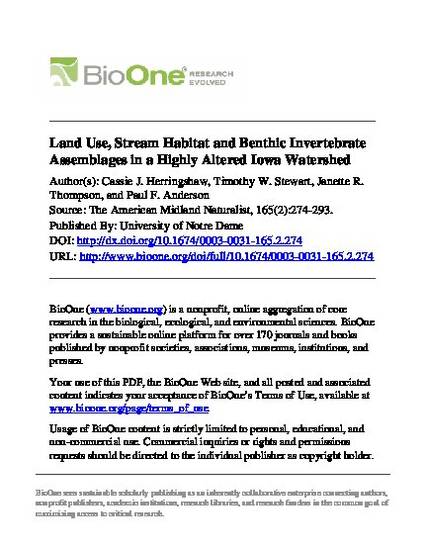
Knowledge of relationships between land cover (i.e., land use) and abiotic and biotic features of headwater streams enhances our ability to predict and effectively assess conditions in a variety of aquatic ecosystems. We evaluated land use effects on stream condition in an Iowa watershed dominated by intensive row crop agriculture and low- intensity urban development by quantifying relationships among land cover, stream invertebrate assemblages and other stream biophysical characteristics (i.e., invertebrate habitat) at 29 sites. On average, 81% of subbasin land cover was agricultural and 6% of land cover was urban across study sites. High nitrate concentrations (range = 5.6–29.0 mg/L) and high relative abundance of oligochaetes and chironomid midges reflected degraded conditions at all sites. However, agriculture and urban land use appeared to have different effects on stream features. Nitrate concentrations were positively related to agricultural land cover, and turbidity and nitrate concentrations were negatively related to urban land cover (P ≤ 0.05). Invertebrate densities and taxonomic diversity (i.e., total taxa richness, % EPT) were also positively related to agricultural land cover and negatively related to urban land cover. Regardless of land use, highest invertebrate abundance and taxonomic diversity occurred at sites with abundant coarse particulate organic matter, plants and coarse inorganic substrate. Relationships between land cover and invertebrate variables were strong at both local and subbasin measurement scales. Based on invertebrate assemblages, which integrate multiple instream features, we conclude that urban land use had greater adverse effect on stream condition than agriculture in our study watershed. Although impacts of urbanization on stream invertebrates frequently exceed effects of agriculture, this has not previously been demonstrated in Iowa or other Midwestern landscapes so heavily dominated by agriculture.
Available at: http://works.bepress.com/timothy_stewart/12/

This article is from American Midland Naturalist 165 (2011): 274, doi:10.1674/0003-0031-165.2.274. Posted with permission.